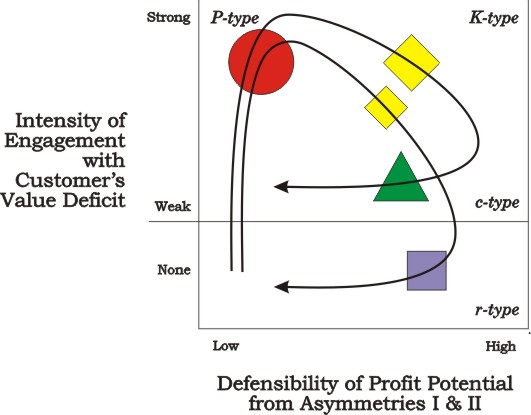by Philip Boxer
How are we to think about the services offered by a business taking power to the edge? One way is in terms of the three asymmetries.
As pointed out here, the economies associated with the first two asymmetries can be secured under conditions of North-South dominance. This means that their profit potential is defensible because the knowledge associated with creating them is asymmetric on the side of the business: the business has something that both its competitors and client-customers do not.
In contrast, the third asymmetry requires East-West dominance capable of delivering an appropriate degree of intensity in the relation the business has to the client-customer’s value deficit, defined in terms of the client-customer’s effects ladder. This intensity reflects the degree to which the business is engaging with the asymmetric nature of the client-customer’s demand – asymmetric on the side of the client-customer. From this we can derive four kinds of value proposition, the first two of which assume no relation to the client-customer’s value deficit:
- r-type: The presumption is that demand is symmetric, and therefore the value proposition is to replicate the offered product or service in as many variants and forms as can be profitably sustained, based on its ability to capture economies of scale. (e.g. pharmaceutical products, telecoms equipment)
- c-type: The value proposition is to offer a combination of products and services that can be dynamically customised in relation to the customer’s demand, based on the ability to capture economies of scope. (e.g. providing injections, or telecoms connections). The value proposition is in delivering a customised product/service where and when it is demanded.
The other two services all have varying degrees of involvement with the client-customer’s context-of-use:
- K-type: the value proposition is to offer the know-how needed dynamically to orchestrate and synchronize the use of products and services in collaboration with the client-customer in solving some part of a larger problem that the client-customer is currently experiencing. (e.g. managing an episode of care, or the way connectivities can be made available to a business in particular types of situation).
- P-type: the value proposition is to offer the ability to work with the client-customer on some area of pain that they are currently suffering, in order to find a way of making it tractable. (e.g. diagnosing what kind of treatment is needed, or defining what kinds of connectivities a business needs).
We can combine these into a diagram that shows the different types of value proposition as a cycle which may or may not end up in the r-type zone:

In each cycle, there is an initial (P-type) proposition that develops with the client-customer a way of addressing its need, experienced by the client-customer as a value deficit (red circle). As the client-customer learns this way of organizing its demands for itself, this may become a (K-type) service managing how particular aspects of those overall needs are being addressed (yellow diamond), these ‘particular aspects’ being the customer situations within the effects ladder generated by the P-type proposition. This will happen if there is some aspect of the K-type know-how that is also defensible. This K-type know-how may become a (c-type) service that the client-customer includes as part of how it takes up this K-type know-how for itself (green triangle). Or the service may end up becoming commoditized and defined purely in terms of its means of production, becoming an (r-type) service (blue square).1
The precise dynamics of these cycles, and the mix of rcKP value propositions offered by a business, will depend on the particular demand and competitive conditions encountered. What I have described, however, are the different kinds of service needed depending on the way in which a client-customer is choosing to internalise learning (or not) as it responds to some aspect of its own particular value deficit.
It follows that if a business is to be able to sustain power at its edge, then the services it offers will involve some mix of K-type and P-type services. The interesting thing about this mix is that its dynamic and collaborative nature makes the services necessarily relational, creating (at least) two-sided markets in the relationships a business has with its client-customers.
Notes
[1] More is written about the rcKP cycle in Understanding Value Propositions and Effects Ladders.